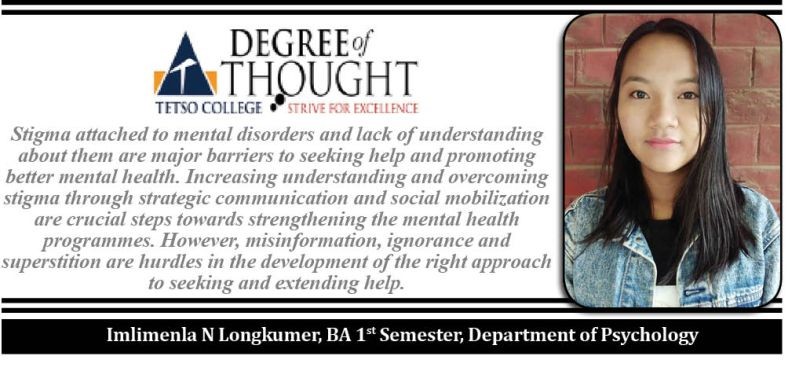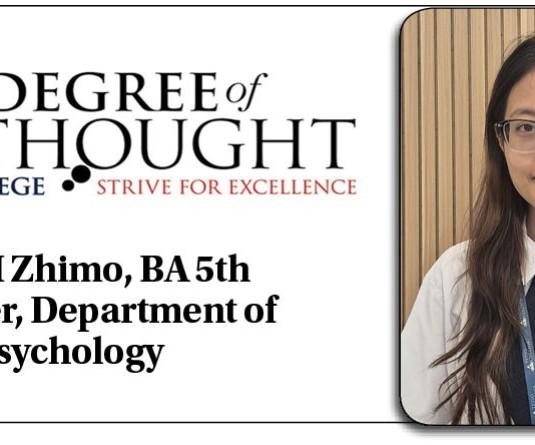
“Mental pain is less dramatic than physical pain, but it is more common and also more hard to bear. The frequent attempt to conceal mental pain increases the burden: it is easier to say “My tooth is aching” than to say “My heart is broken.” - CS Lewis
Mental health is a major concern worldwide and India is not far behind in sharing this. If we evaluate the development in the field of mental health, the pace appears to be slow. Dr. Brock Chisholm, the first Director-General of the World Health Organization (WHO), in 1954, had presciently declared that “without mental health there can be no true physical health.” The burden of mental disorder is likely to have been underestimated because of the inadequate appreciation towards inter-play between mental illness and other health disorders. There remain considerable issues of priority-setting based on the burden of health problems, of addressing the inequalities in relation to determinants, and solutions for health problems.
The progress in mental health service delivery has been slow in most countries with low and middle income families. Lack of knowledge about the mental illnesses poses a challenge to the mental health care delivery system. These barriers include the existing public-health priorities and its influence on funding, challenges in the delivery of mental health care in primary-care settings, inadequate trained personnel in mental health care service, and the lack of mental health perspective in public-health leadership.
Thus, it becomes now opportune to explore the paradigm of mental health awareness as a means of enhancing prevention, ensuring early recognition, stimulating simple and practical interventions, and combating stigma within the community. Today there are opportunities in terms of growing acknowledgement of mental disorders as key targets of global health action; such as how leveraging new technologies, particularly the internet, big data and cell phones in amplifying simple field interventions, are found successful in primary care and other stratum.
Stigma involves negative attitudes or discrimination against someone based on a distinguishing characteristic such as a mental illness, health condition, or disability. Social stigmas can also be related to other characteristics including gender, sexuality, race, religion, or culture. Stigma and discrimination are negative consequences of ignorance and misinformation. With regard to this, a study was conducted and it was found that mental health literacy among adolescents is very low, i.e. depression was identified by 29.04% and schizophrenia/psychosis was recognized only by 1.31%; also, stigma was noted to be present in help-seeking. These findings reinforce the need to increase awareness of mental health. (Mental health literacy among late Adolescents: JM Ogorchukwu – 2016)
Depression also is a predominant mental health problem worldwide followed by anxiety, schizophrenia and bipolar disorder. Most people who experience mental health problems can recover fully, or are able to live with and manage them, especially if they get help early on. But, even though so many people are affected, there is a strong social stigma attached to mental health problems, and people with mental health problems can experience discrimination in all aspects of their lives. The condition of majority of people suffering with mental issues is made worse by the stigma they have to bear and the discrimination they experience from families, friends and employers in the society. We know that people with mental health problems are amongst the least likely to find work; to be in steady long-term relationships; to live in decent housing or be socially included in mainstream society. Often, people speak with a friend, family member or faith leader before they talk to a mental health professional. But, if we look closely, it is from such families or peer groups itself that the person with poor mental health is stigmatized. There is a massive gap of disgust created towards the mentally ill.In most cases they are treated unfairly, and often dragged into isolation with the absence of adequate basic necessities. This, in turn, multiplies the mental health problems until one is physically and emotionally drained to the point of wanting to inflict self-harm and taking their own lives. Many people believe that people with mental health problems are violent and dangerous, when in fact they are more vulnerable and at risk at harming themselves than to harm other people.
Stigma and discrimination can gradually contribute to worsening of one’s mental health problems and can also impede their treatment and recovery. Social isolation, poor housing, unemployment and poverty are also factors that are linked to stigma and discrimination.. So, this can trap people in a cycle of illness. Research shows that the best way to challenge these stereotypes is through firsthand contact with people with experiences of mental health problems and intimate awareness and exposure of society to this very important issue. A number of national and local campaigns are trying to change public attitudes towards mental health problems. Breaking this stigma requires courage and a need to educate the public that mental health problems are treatable and recovery is possible.
What can we do to combat stigma?
- The fact that mental illness is common and treatable, we should talk openly about mental health in the society.
- We should educate ourselves and others, and learn more about mental recovery. By knowing the signs and how to help, we can save a life.
- “A healthy mind in a healthy body”, which means a healthy body sustains a healthy mind. So much of what we do physically impacts us mentally, it’s important to pay attention to both your physical and mental health.
- Show compassion towards those with mental illness.
- Get help from the counsellors, teachers or administrators.
- Speak out against stigma. Consider expressing your opinions at events and in write ups.
- Join a support group.
Degree of Thought is a weekly community column initiated by Tetso College in partnership with The Morung Express. Degree of Thought will delve into the social, cultural, political and educational issues around us. The views expressed here do not reflect the opinion of the institution. Tetso College is a NAAC Accredited UGC recognised Commerce and Arts College. The editors are Dr Hewasa Lorin, Dr Aniruddha Babar, Nisha Dahiya and Meren. For feedback or comments please email: dot@tetsocollege.org






